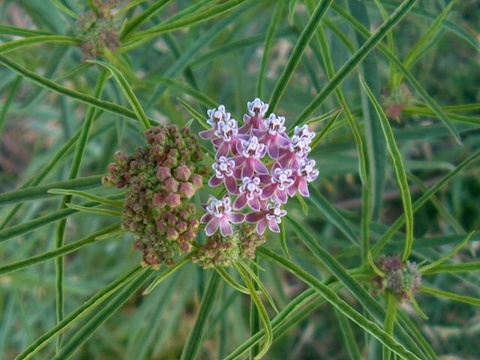Milkweeds are perennial forbs in the Asclepias genus of the dogbane family. They are an essential food source for many insects and the only food source for monarch butterfly larvae. Most mammals and birds will be poisoned if they eat milkweed. Monarch butterfly larvae have evolved to use the poisonous properties of milkweed to make themselves poisonous and distasteful to their predators, but this protective mechanism only works if the monarch larvae eat the native species of milkweed that they have evolved with. Planting non-native milkweed species can significantly damage the local monarch butterfly population.
Milkweeds in the Yuba-Sutter area virtually always have several large milkweed bugs crawling on them. Milkweeds also attract a wide variety of butterflies. The nectar of milkweed flowers is a favorite drink for many butterflies, including the local Northern checkerspot, orange sulfur, monarch, gorgon copper, umber skipper, Propertius duskywing, two-tailed swallowtail, Western tiger swallowtail, Acmon blue, Calippe fritillary, West Coast lady, and American lady butterflies, as well as for the local bumblebee moth. In addition, milkweed leaves are the only food that the caterpillars of monarch butterflies can eat. Even milkweed leaves can be unhealthy for monarch caterpillars to eat, if the leaves are not from a native milkweed species that the monarchs have co-evolved with.
Narrowleaf Milkweed
 Narrowleaf milkweed (Asclepias fascicularis) in a garden in Marysville. Photo by queerbychoice. Narrowleaf milkweed (also called Mexican whorled milkweed) is a two- to three-foot-tall, pink-flowering milkweed that is native to Sutter County and typically grows at elevations below 7,000 feet. It is most often found on dry ground in central oak woodland, valley grassland, yellow pine forest, and riparian forest. It is equally likely to grow in wetlands or non-wetlands.
Narrowleaf milkweed (Asclepias fascicularis) in a garden in Marysville. Photo by queerbychoice. Narrowleaf milkweed (also called Mexican whorled milkweed) is a two- to three-foot-tall, pink-flowering milkweed that is native to Sutter County and typically grows at elevations below 7,000 feet. It is most often found on dry ground in central oak woodland, valley grassland, yellow pine forest, and riparian forest. It is equally likely to grow in wetlands or non-wetlands.
You can read more about it at the Theodore Payne Wiki and the Las Pilitas Nursery website. You can see pictures of it at CalPhotos, Flickr, and Picasa. You can find out where to buy it at the California Native Plant Link Exchange.
Indian Milkweed
Indian milkweed (also called Kotolo milkweed) is a two- to three-foot-tall, white- or cream-flowering milkweed that is native to Yuba and Sutter Counties and typically grows at elevations below 7,000 feet. It is most often found in dry, barren areas in central oak woodland, valley grassland, or yellow pine forest. The Nisenan people extracted tough fibers from the stems to make cords, ropes, and coarsely woven cloth. They also pulverized the seeds to use when cleaning cuts and sores.1
You can read more about it at the Theodore Payne Wiki and the Las Pilitas Nursery website. You can see pictures of it at CalPhotos, Flickr, and Picasa. You can find out where to buy it at the California Native Plant Link Exchange.
Purple Milkweed
Purple milkweed (also called heartleaf milkweed) is a one- to three-foot-tall, purple-flowering milkweed that is native to Yuba and Sutter Counties and typically grows at elevations below 6,500 feet. It is most often found on slopes in central oak woodland or yellow pine forest. Unlike many other milkweeds, it does not usually spread to form colonies.
You can read more about it at the Las Pilitas Nursery website. You can see pictures of it at CalPhotos, Flickr, and Picasa. You can find out where to buy it at the California Native Plant Link Exchange.
Showy Milkweed
Showy milkweed is a four- to five-foot-tall, pink-flowering milkweed that is native to Yuba County and typically grows at elevations below 6,000 feet. It is most often found in fields and along roadsides in yellow pine forest or riparian forest. It prefers full sun and is equally likely to grow in wetlands or non-wetlands. The Nisenan people extracted tough fibers from the stems to make cords, ropes, and coarsely woven cloth. They also pulverized the seeds to use when cleaning cuts and sores.2
You can read more about it at the Theodore Payne Wiki, the Las Pilitas Nursery website, and USDA Conservation Plant Characteristics. You can see pictures of it at CalPhotos, Flickr, and Picasa. You can find out where to buy it at the California Native Plant Link Exchange.
Footnotes
1. Wildflowers of Nevada and Placer Counties by the California Native Plant Society Redbud Chapter. Sacramento: CNPS Press, 2007
2. Wildflowers of Nevada and Placer Counties by the California Native Plant Society Redbud Chapter. Sacramento: CNPS Press, 2007


